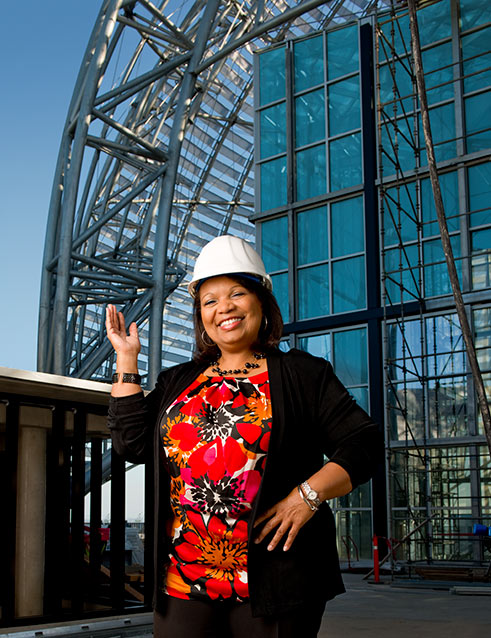22 April 2013
A few words on the future of libraries
By Henry DeVries
San Diego City Librarian Deborah Barrow is busy with final preparations for a new downtown central library to open this summer, but she’s not too busy to ponder the future role of libraries.
 In today’s digital age when most Americans have access to plentiful information on the Internet, it is not uncommon to hear questions about the evolution of and vision for public libraries. Far from fearing obsolescence, Barrow has a clear view of the future—libraries will always be in the business of connecting people with information.
In today’s digital age when most Americans have access to plentiful information on the Internet, it is not uncommon to hear questions about the evolution of and vision for public libraries. Far from fearing obsolescence, Barrow has a clear view of the future—libraries will always be in the business of connecting people with information.
“Libraries are centers of knowledge, and knowledge does not get old,” says Barrow, who leads a system with thirty-five branch libraries visited by more than six million patrons annually and served by nearly four hundred employees. “Knowledge will always be there to be grasped by anyone who wants it and we are one of the conduits to help them.”
Throughout history, libraries have served as a treasury, a protected storehouse of important books and documents. In 1455, Johann Gutenberg unveiled his printing press to the world, ushering in a printing revolution that saw over five hundred thousand books put into circulation before the year 1500. Private libraries were needed to house those precious manuscripts.
“In medieval times, books were valuable possessions far too expensive for most people to own,” says Thomas Frey, executive director of the DaVinci Institute. “As a result, libraries often turned into a collection of lecterns with books chained to them. We have transitioned from a time where information was scarce and precious to today where information is vast and readily available, and, in many cases, free.”
Libraries are undergoing change in the age of Amazon.com, iPhone, and Wikipedia. With the vast amount of information available in the world today, some have likened searching for answers in the digital age to trying to take a sip of water from a wide open fire hydrant.
“According to a recent PEW Research Center study, 91 percent of Americans sixteen or older say public libraries are important to their communities,” says Barrow. “We are the place where free information is available, where there are tools available to find it, and where people are there to help navigate the search.”
A great library is also a setting to allow people to work collectively, hold meetings, and foster community-building conversations—quite the opposite of the stereotypical librarian running around shushing people to be quiet. “For example, students are being encouraged to study and do projects together,” says Barrow. “Now you need to be able to talk at the library; otherwise, how are you going to communicate your ideas about the project you are working on together?”
Designed to that end, the new library is a nine-story building of flexible spaces with diverse and accessible public amenities. Bay-view terraces, roof gardens and a public reading room reflect and celebrate San Diego’s natural beauty and temperate climate. The library’s open spaces are designed to invite patrons to explore exhibits or relax with new-found reading material. Unique features include a flexible special events room on the ninth floor, a state-of-the-art auditorium, and a beautiful reading room under the signature lattice dome—creating a distinct and extraordinary facility.

The plan allows the library to fulfill its crucial role as the heart of the branch system. There is plentiful space to deliver children’s and adult programs, provide disabled access, offer technology and web-based services, and answer reference questions from throughout the region.
“At the new library, we will provide digital access and plan to have as many as four hundred computers available for people to use,” says Barrow. “But the library is something beyond the books and materials. There’s a cultural and social value to the library. It’s a place people go to gather.”
The 492,495 square foot central library includes an outdoor plaza and café, 350-seat auditorium, three-story domed reading room, 400-seat multi-purpose room, teen center, 10,244 square foot children’s library, technology center, and two levels of underground parking.
Barrow is a firm believer that libraries change lives. A San Diego native whose father worked at the Navy base on North Island and mother worked at the UC San Diego library, she has fond memories of her time spent in libraries while growing up. Her love of learning led her to a bachelor’s degree in anthropology from Scripps College and a master’s degree in library science from the University of Southern California.
“I have had so many people come to me and tell me how the library has made a difference for them,” says Barrow. “One of our city engineers said to me, ‘I am so happy to be working on the new library project. When I came to San Diego and didn’t have a computer to look for a job, the way I sent my resumes out was through the library computer.’ This is someone I consider to be in a high level city job who is telling me about this experience.”
In recognition of the continuing importance of libraries, donors have stepped up to support the project. Thanks to the leadership of the Library Foundation’s Mel Katz, Judith C. Harris, and Katie Sullivan, the Library Foundation has become a model for public-private partnerships by raising more than $65 million from private and corporate donors for the new central library.